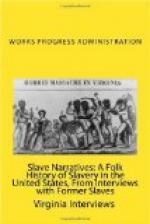Following are some questions and her answers:
“Lucy, did you belong to the Carrolls before the war?” “Nosah, I didne lib around heah den. Ise born don on de bay”.
“How old are you?”
“Dunno sah. Miss Anne, she had it written down in her book, but she said twas too much trouble for her to be always lookin it up”. (Her son, Lafayette, says he was her eldest child and that he was born on the Severn River, in Maryland, the 15th day of October, 1872. Supposing the mother was twenty-five years old then, she would be about ninety now. Some think she is more than a hundred years old).
“Who did you belong to?”
“I belonged to Missus Ann Garner”.
“Did she have many slaves?”
“Yassuh. She had seventy-five left she hadnt sold when the war ended”.
“What kind of work did you have to do?”
“O, she would set me to pickin up feathers round de yaird. She had a powerful lot of geese. Den when I got a little bigger she had me set the table. I was just a little gal then. Missus used to say that she was going to make a nurse outen me. Said she was gwine to sen me to Baltimo to learn to be a nurse”.
“And what did you think about that?”
“Oh; I thought that would be fine, but he war came befo I got big enough to learn to be a nurse”.
“I remebers when the soldiers came. I think they were Yankee soldiers. De never hurt anybody but they took what they could find to eat and they made us cook for them. I remebers that me and some other lil gals had a play house, but when they came nigh I got skeered. I just ducked through a hole in the fence and ran out in the field. One of the soldiers seed me and he hollers ’look at that rat run’.”
“I remebers when the Great Eastern (steamship which laid the Atlantic cable) came into the bay. Missus Ann, and all the white folks went down to Fairhaven wharf to see dat big shep”.
“I stayed on de plantation awhile after de war and heped de Missus in de house. Den I went away”.
“Ise had eight chillun. Dey all died and thisun and his brother (referring to Lafayette). Den his brother died too. I said he ought ter died instid o his brother.”
“Why?”
“Because thisun got so skeered when he was little bein carried on a hos that he los his speech and de wouldt let me see im for two days. It was a long time befor he learned to talk again”. (To this day he has such an impediment of speech that it is painful to hear him make the effort to talk).
“What did you have to eat down on the plantation, Aunt Lucy?”
“I hab mostly clabber, fish and corn bread. We gets plenty of fish down on de bay”.
“When we cum up here we works in the ole Forest Glen hotel. Mistah Charley Keys owned the place then. We stayed there after Mr. Cassidy come. (Mr. Cassidy was the founder of the National Park Seminary, a school for girls). My son Lafayette worked there for thirty five years. Then we cum to Carroll Springs Inn”.




